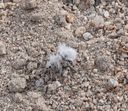Dasymutillini
Dasymutillini
Classification
- Phylum: Arthropoda
- Subphylum: Hexapoda
- Class: Insecta
- Order: Hymenoptera
- Superfamily: Pompiloidea
- Family: Mutillidae
- Subfamily: Sphaeropthalminae
- Tribe: Dasymutillini
Pronunciation
How to pronounce Dasymutillini: /ˌdæsɪmjuːˈtɪlɪnaɪ/
These audio files are automatically generated. While they are not always 100% accurate, they are a good starting point.
Images






Summary
Dasymutillini is a tribe containing wasp-like insects commonly known as velvet ants, comprising the genera Dasymutilla and Lomachaeta. They are known for their painful stings and mimicry adaptations.
Physical Characteristics
Members of the genus Dasymutilla have a remarkably strong exoskeleton and exhibit aposematic coloration. They are known for producing a loud squeaking noise.
Identification Tips
Certain species within Dasymutilla can be identified by their distinctive coloration and by their painful sting, which ranges in intensity according to the species.
Habitat
Primarily found in areas where ground-nesting Hymenoptera exist, as they are external parasites to these insects.
Distribution
New World and Australasia.
Diet
Larvae are external parasites on various types of ground-nesting Hymenoptera.
Life Cycle
Not specifically detailed; however, the larvae develop externally on their hosts, indicating a parasitic life cycle.
Predators
Known aposematic coloration and mimicry help to deter predators.
Ecosystem Role
As external parasites of ground-nesting Hymenoptera, they may play a role in controlling these host populations.
Health Concerns
Certain species have a painful venomous sting, notably Dasymutilla klugii, which can cause significant pain.
Similar Taxa
Misconceptions
Often mistaken for bees or wasps due to their appearance, despite being more closely related to ants.
Tags
- Dasymutillini
- velvet ants
- Hymenoptera
- Mutillidae
- parasitic wasps